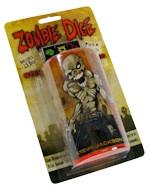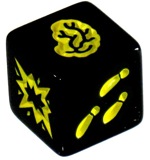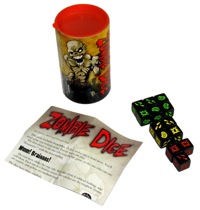by Lee Valentine
 Zombie Dice
Zombie Dice
Published by Steve Jackson Games (2010)
Designed by Steve Jackson
Contents: 13 dice, dice cup, rules sheet
2 or more players
$13.13
This game is featured in the OgreCave Christmas Gift Guide 2010.
Steve Jackson Games just released a new "press your luck" dice game
called Zombie Dice. I originally saw this game earlier this year
at PAX East in Boston, MA (see my PAX East
convention report for my impressions of the show). At a price of
$13.13, the game comes with 13 custom six-sided dice and a dice cup.
The latter is used both during the game and for storage.
Gameplay
The dice feature icons rather than pips or numbers. There are three
kinds of icons on the faces of the dice: brains, shotgun blasts, and
footsteps ("Runners"). You play the roll of a brain-eating zombie
chasing down 13 potential victims. Each turn, you put the dice into the
dice cup that is provided with the game and give the cup a shake, then
pull out three random dice and roll them.
After each toss, you set aside all brains and shotgun blasts rolled.
Each brain icon rolled is one potential point that you could score this
turn so long as you collect those points before you take too much
shotgun damage. You can stop rolling at any time and score one point
for every brain rolled this turn. Shotgun blasts rolled represent armed
victims who have defended themselves and injured you with a shotgun. If
you roll a cumulative total of three shotgun blasts during your turn
then your turn ends immediately and you lose all points that you might
have accumulated that turn from rolling brain icons (though you keep
points scored during earlier turns). After each roll of three dice you
decide whether you will end your turn and bank the brain points you've
scored. If you do, you add those points to your total score for the
game, put the dice back in the cup, and you pass the cup to the next
player. If you decide to press your luck, you'll roll three dice again.
Runners represent the victims who narrowly escaped you last time, but
who are still within reach if you can catch them before they find a
shotgun. If you rolled any "Runners" on your previous roll and you
decide to press your luck, then you must re-roll all those Runners, plus
enough new dice drawn randomly from the cup to bring the total number of
dice that you are rolling up to three.
The goal is to get to 13 points of brains eaten. Once a player ends his
turn with 13 or more points, the remaining players after him in the turn
order get one last turn. At that point, the player with the highest
number of points is declared the winner.
 Zombie Dice introduced something new to me in the "press your
luck" genre: not all the dice are the same. Among the game's 13 dice
there are six green dice, four yellow dice, and three red dice. Each
die has two "Runners" faces. Green dice also have three brains and one
shotgun. Yellow dice have two brains and two shotguns. Red dice, the
most dangerous, have one brain icon and three shotguns. Since you
always re-roll all your Runners, and since your brains and shotguns
represent dice set aside, you can guesstimate how dangerous your next
roll might be. For example, if you rolled two red brains, one red
shotgun, one yellow brain, and you have two green Runners to re-roll,
then your next roll will probably be relatively safe for you.
Zombie Dice introduced something new to me in the "press your
luck" genre: not all the dice are the same. Among the game's 13 dice
there are six green dice, four yellow dice, and three red dice. Each
die has two "Runners" faces. Green dice also have three brains and one
shotgun. Yellow dice have two brains and two shotguns. Red dice, the
most dangerous, have one brain icon and three shotguns. Since you
always re-roll all your Runners, and since your brains and shotguns
represent dice set aside, you can guesstimate how dangerous your next
roll might be. For example, if you rolled two red brains, one red
shotgun, one yellow brain, and you have two green Runners to re-roll,
then your next roll will probably be relatively safe for you.
The game has better decision points than a dice game like LCR.
The scoring, however, is easier to memorize than it would be for
Yahtzee or Farkle. Since there's nominally no upper limit
to the number of players (other than your patience for downtime between
your chance to roll the dice), Zombie Dice is ideally suited to
parties.
Components and Packaging
 The game comes complete with an attractive dice cup decorated with
zombie art by Alex Fernandez. The construction of the cup is almost
identical to a nice container for frozen, concentrated orange juice but
with a glossy, full-color label and removable lid. The dice cup is
sturdy and portable, but it is handled regularly and roughly, so the art
on the outside will pick up some scuffs pretty quickly, particularly at
the mouth of the cup. The bottom of the container is also removable,
and this might pose a potential problem if the bottom of the cup falls
out causing the 13 dice that you are shaking to cascade to the floor.
That hasn't happened to me yet – I have seen the container bottom
becoming a bit loose occasionally during play, but it usually holds
firm.
The game comes complete with an attractive dice cup decorated with
zombie art by Alex Fernandez. The construction of the cup is almost
identical to a nice container for frozen, concentrated orange juice but
with a glossy, full-color label and removable lid. The dice cup is
sturdy and portable, but it is handled regularly and roughly, so the art
on the outside will pick up some scuffs pretty quickly, particularly at
the mouth of the cup. The bottom of the container is also removable,
and this might pose a potential problem if the bottom of the cup falls
out causing the 13 dice that you are shaking to cascade to the floor.
That hasn't happened to me yet – I have seen the container bottom
becoming a bit loose occasionally during play, but it usually holds
firm.
The dice are simple and well-made, featuring nice, clear icons. The
rules are on a small two-sided rules sheet, which folds up to be tucked
into the cup for storage, though I doubt you'll ever need it again after
playing the game even once.
I thought the components were great overall for the price, but the game
came without an internal means of scorekeeping. Presumably you can
either write down your scores or memorize them. Ideally the game should
have come with some game stones to keep track of scores visually, and
indeed the folks at the SJG booth at PAX East were using a combination
of Munchkin-themed coins and game stones for scoring during
demos.
Conclusions
While heavily luck-based, there are some tense decision points during
each of your turns (assuming that you don't get three shotgun blasts on
your first roll). You need to be greedy to win, but zombies who are too
greedy for brains will generally meet their untimely end each turn at
the wrong end of a shotgun or three. Zombie Dice is fast and
well-suited toward party crowds of gamers and non-gamers alike. The
game generates a lot of laughter and trash talking, which is great for a
party environment. The rules can be explained quickly so you can get
right into playing. Games are short (often 10-15 minutes), allowing
people to join or drop out quickly between games. Unfortunately, the
luck heavy aspects of the game will limit the replay value of the game
for serious gamers, but for kids and non-gamers at parties this is a
really clever little "press your luck" game. It's also suitable as a
quick filler game when you are waiting for the rest of your gaming group
to show up. Given the nature of the game, it's probably easily adapted
to a gambling game (with side bets like craps) or a drinking game if you
are so inclined.
Even if you were turned off by the SJG game Cthulhu Dice (see the
OgreCave review here),
Zombie Dice is worth a second look. Zombie Dice has a
little bit more meat on its bones and uses a different rules set than
Cthulhu Dice. The zombie theme is lightly pasted on though, so
this is not a must buy for serious zombophile gamers. However, if you
are looking for a light game that you might play now and again instead
of a game that you put into regular rotation with your gaming group,
then the price is right on this one. I wouldn't be surprised if someone
finds a way to use these dice in an RPG or war game or even for skill
checks in board games like Arkham Horror.
For Retailers
The game is sold with eight games to each POP display. The POP display
is attractive, and is constructed like an oversized CCG game display.
However, each individual game unit also comes with a hang hole suitable
for display on a wall instead. Each game has a clear plastic blister
pack showing the dice cup and one each of the green, yellow, and red
dice, to give customers an instant idea of what they are purchasing. If
lighter SJG games or dice games sell well for you, then this is a no
brainer (pun intended), the game might have sold more copies as an
October release. I am not sure that there is enough replay value in
this game for this to become an evergreen product in your store, but the
price is right for an impulse buy. So this is probably worth carrying,
particularly if you display it close to the cash register. I actually
suspect that if you have a bunch of casual gamers in your store then
this will sell better for you because of the mass market nature of the
gameplay. If, however, you have mostly hardcore gamer geeks as your
customer base, then the ÒB+Ó salability rating I gave below probably
won't apply to you. This demos fast, even by the cash register, and
since the game is short, you can easily have in-store demos made up of
full-length games to promote sales.
Lee's ratings:
Overall: B (weighted down by lack of depth in gameplay)
Appearance: B+ (great Alex Fernandez art on the dice cup, and nice iconography on the dice)
Components: B+ (nice dice, but no score pad, mini poker chips, or game stones provided to keep score)
Packaging: B+ (the dice cup is awesome for storage and looks great, but appears that it will sustain wear quickly during actual gameplay)
Rules Clarity: A
Gameplay: B (as a light filler or party game), but potentially lower for consumers looking for a meatier game with more replay value
Retailer Salability: B+ (if SJG games or mass market dice games sell well for you, otherwise lower)
Links:


 Zombie Dice
Zombie Dice Zombie Dice introduced something new to me in the "press your
luck" genre: not all the dice are the same. Among the game's 13 dice
there are six green dice, four yellow dice, and three red dice. Each
die has two "Runners" faces. Green dice also have three brains and one
shotgun. Yellow dice have two brains and two shotguns. Red dice, the
most dangerous, have one brain icon and three shotguns. Since you
always re-roll all your Runners, and since your brains and shotguns
represent dice set aside, you can guesstimate how dangerous your next
roll might be. For example, if you rolled two red brains, one red
shotgun, one yellow brain, and you have two green Runners to re-roll,
then your next roll will probably be relatively safe for you.
Zombie Dice introduced something new to me in the "press your
luck" genre: not all the dice are the same. Among the game's 13 dice
there are six green dice, four yellow dice, and three red dice. Each
die has two "Runners" faces. Green dice also have three brains and one
shotgun. Yellow dice have two brains and two shotguns. Red dice, the
most dangerous, have one brain icon and three shotguns. Since you
always re-roll all your Runners, and since your brains and shotguns
represent dice set aside, you can guesstimate how dangerous your next
roll might be. For example, if you rolled two red brains, one red
shotgun, one yellow brain, and you have two green Runners to re-roll,
then your next roll will probably be relatively safe for you. The game comes complete with an attractive dice cup decorated with
zombie art by Alex Fernandez. The construction of the cup is almost
identical to a nice container for frozen, concentrated orange juice but
with a glossy, full-color label and removable lid. The dice cup is
sturdy and portable, but it is handled regularly and roughly, so the art
on the outside will pick up some scuffs pretty quickly, particularly at
the mouth of the cup. The bottom of the container is also removable,
and this might pose a potential problem if the bottom of the cup falls
out causing the 13 dice that you are shaking to cascade to the floor.
That hasn't happened to me yet – I have seen the container bottom
becoming a bit loose occasionally during play, but it usually holds
firm.
The game comes complete with an attractive dice cup decorated with
zombie art by Alex Fernandez. The construction of the cup is almost
identical to a nice container for frozen, concentrated orange juice but
with a glossy, full-color label and removable lid. The dice cup is
sturdy and portable, but it is handled regularly and roughly, so the art
on the outside will pick up some scuffs pretty quickly, particularly at
the mouth of the cup. The bottom of the container is also removable,
and this might pose a potential problem if the bottom of the cup falls
out causing the 13 dice that you are shaking to cascade to the floor.
That hasn't happened to me yet – I have seen the container bottom
becoming a bit loose occasionally during play, but it usually holds
firm.